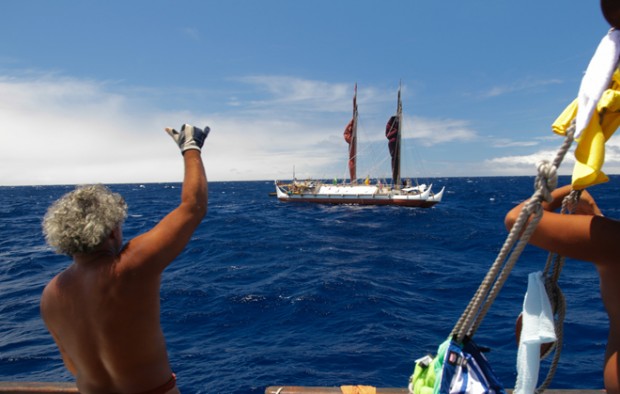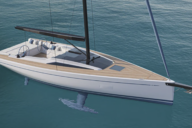Strong, steady trades and lighter, swifter hulls are so far helping Hokule‘a make its fastest time yet to Tahiti, crews sailing on the first international leg of the voyaging canoe’s worldwide journey report.
“We’re just humming along,” Capt. Bruce Blankenfeld said via satellite phone Tuesday aboard Hikianalia, Hokule‘a’s escort vessel. “Both canoes are sailing really well, and the wind has been excellent. It’s allowed us to make much better speed. It’s allowed us to make better mileage.”
Twelve days after crew members left Hilo to launch the three-year Malama Honua (“Care for Our Earth”) worldwide voyage, Blankenfeld estimated that the double-hulled canoes have already sailed about two-thirds of the way to Tahiti.
Crews aboard Hokule‘a are using way-finding — the noninstrumental navigation techniques of their Polynesian ancestors — to guide the two canoes to Tahiti, about 2,600 miles southeast of Hawaii.
A Google-based map showing the boats’ GPS location shows that Hokule‘a and Hikianalia have logged nearly 1,700 miles since leaving Palekai, also known as Radio Bay, in Hilo.
The trip to Tahiti is Hokule‘a’s first voyage outside Hawaii and into the open ocean since completing an 18-month dry dock in 2012, during which the canoe was basically rebuilt. Polynesian Voyaging Society members and volunteers replaced waterlogged wood and rot with a foam core and state-of-the-art materials — “just making it stronger,” Blankenfeld said Tuesday as the seas around him started getting a bit rougher and messier.
Despite the material upgrades, the 39-year-old canoe retains its traditional design modeled after ancient Polynesian way-finding canoes, he added.
The repairs also made Hokule‘a a full ton lighter, Blankenfeld said, helping the wa‘a (canoe) to sail faster.
In addition, the canoes saw good fortune in recent days as they passed through what’s known as the intertropical convergence zone around the equator, Blankenfeld said. That area, often called “the doldrums,” is a stretch that is frequently marked by stagnant winds.
The zone often varies in size and location, and it has slowed Hokule‘a’s progress on previous voyages south. However, on this trip “we barely slowed down at all,” Blankenfeld said.
The two boats’ 29 crew members — many of them younger than 30 years old and experiencing their first open sea voyage — are thriving, and that’s another key reason for the progress, Blankenfeld said.
“The crew is doing especially well. The morale is great. They’re learning daily, everything about life at sea,” he said. “The diligence, the vigilance that’s required.”
After landing in Tahiti, Hokule‘a and Hikianalia will undergo Malama Honua’s second leg, to Samoa.
Courtesy of www.staradvertiser.com












